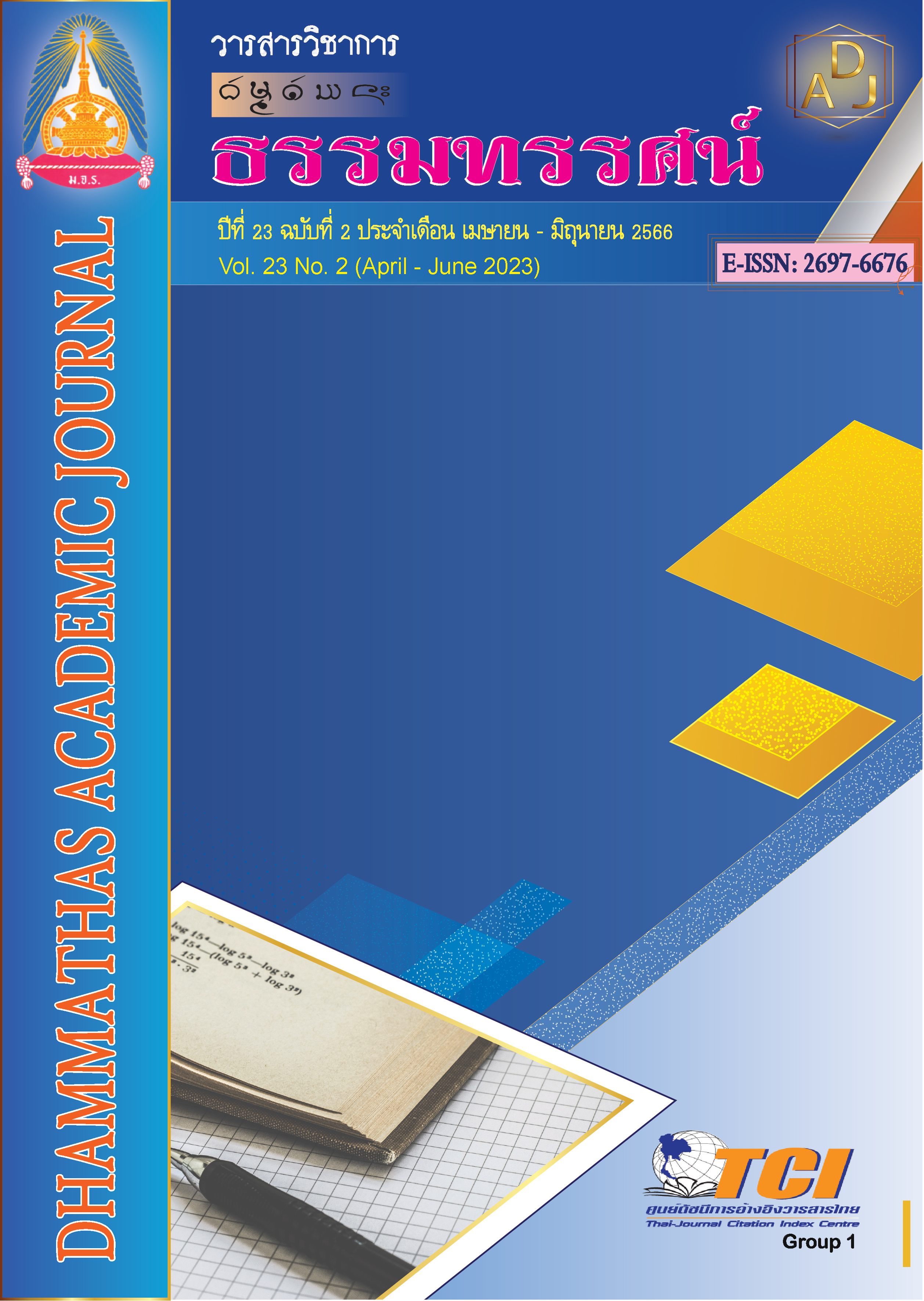Is Nong Khai Properly Prepared for Chinese Tourists Arriving on the Lao-China Railway Link? The Research is a Study of Signs at Tourist Spots of Cutural Interest in Nong Khai Province
Main Article Content
Abstract
The purposes of this research are: 1) To survey Chinese text signs in Nong Khai’s cultural Tourist attractions and 2) To evaluate the quality of language on the text signs by using the quantitative and qualitative method. The documentary research method is used as the research methodology. The data was collected by surveying the text signs in 25 of Nong Khai’s tourist attractions and relevant private and government organizations in 4 districts; Muang District, Tha Bo District, Sri Chiang Mai District and Sang Khom, to analyze and evaluate the readiness of Chinese text signs for Chinese tourists traveling to Nong Khai on the Lao-China railway.
The research results find that:
1. The total of 292 texts signs for tourists in 25 of Nong Khai’s Cultural tourist attractions were divided into 3 categories; tourist information signs, compliance and guideline signs and prohibition signs. There were only 27 text signs containing the Chinese language accounting for 9.25 percent. The proportion of Thai and Chinese text signs indicated that Chinese text signs were still very low in number and not enough to service Chinese tourists who will visit Nong Khai through the Lao-China railway. The distribution of the frequency of Chinese text signs shows that most of the Chinese text signs are still concentrated in only some attractions in the Muang district.
2. Based on an evaluation of the accuracy of Chinese on the text signs, it was found that 5 signs contained 27 errors. The errors can be divided into 2 types; 1) the errors which affect the correctness of information for tourists including mistranslation, over translation, and under translation 2) the errors which affect clear and effective communication with tourists including proper word choice selection and structural and grammatical errors. Moreover, there are some cases, which can affect tourist understanding such as mixed use of traditional and simplified Chinese characters, and the variety of word use with the same meaning in different locations.
Article Details

This work is licensed under a Creative Commons Attribution-NonCommercial-NoDerivatives 4.0 International License.
เพื่อให้เป็นไปตามกฎหมายลิขสิทธิ์ ผู้นิพนธ์ทุกท่านต้องลงลายมือชื่อในแบบฟอร์มใบมอบลิขสิทธิ์บทความ ให้แก่วารสารฯ พร้อมกับบทความต้นฉบับที่ได้แก้ไขครั้งสุดท้าย นอกจากนี้ ผู้นิพนธ์ทุกท่านต้องยืนยันว่าบทความ ต้นฉบับที่ส่งมาตีพิมพ์นั้น ได้ส่งมาตีพิมพ์เฉพาะในวารสาร วิชาการธรรม ทรรศน์ เพียงแห่งเดียวเท่านั้น หากมีการใช้ ภาพหรือตารางของผู้นิพนธ์อื่นที่ปรากฏในสิ่งตีพิมพ์อื่นมาแล้ว ผู้นิพนธ์ต้องขออนุญาตเจ้าของลิขสิทธิ์ก่อน พร้อมทั้ง แสดงหนังสือที่ได้รับการยินยอมต่อบรรณาธิการ ก่อนที่บทความจะได้รับการตีพิมพ์References
กรวรรณ พรหมแย้ม. (2565). การศึกษาภูมิทัศน์ทางภาษาศาสตร์ด้านภาษาจีนและกลวิธีการแปลชื่อธุรกิจร้านค้าในสถานที่ท่องเที่ยวจังหวัดเชียงใหม่. มนุษยศาสตร์สาร, 23(1), 209-230.
กฤตพล วังภูสิต. (2555). ชื่อธุรกิจการค้าในย่านสยามสแควร์: การศึกษาตามแนวภูมิทัศน์เชิงภาษาศาสตร์. (วิทยานิพนธ์อักษรศาสตรมหาบัณฑิต). กรุงเทพฯ: จุฬาลงกรณ์มหาวิทยาลัย.
กฤตภัทร ถาปาลบุตร, ธีรศักดิ์ สิงห์ปรีชา และเขมโชต ภู่ประเสริฐ. (2552). กระบวนการมีส่วนร่วมในการพัฒนาชุมชน เพื่อการท่องเที่ยวชายแดนไทย-ลาว กรณีศึกษา ชุมชนเมืองเก่าริมแม่น้ำโขง ด่านสะพานมิตรภาพไทยลาว จังหวัดหนองคาย. (รายงานการวิจัย). ขอนแก่น: มหาวิทยาลัยขอนแก่น.
กัลปพฤกษ์ เกื้อเกตุ. (2541). การวางแผนพัฒนาความพร้อมเพื่อรองรับการเติบโตการท่องเที่ยวชายแดน: กรณีศึกษาเมืองหนองคาย. กรุงเทพฯ: จุฬาลงกรณ์มหาวิทยาลัย.
จิตต์สิรี ทองน้อย. (2565). รถไฟจีน-ลาว กับโอกาสธุรกิจที่ไทยกำลังไล่คว้า และความท้าทายที่เกษตรกรเผชิญ. เข้าถึงได้จาก https://www.bbc.com/thai/60248500
จิราพร เนตรสมบัตร. (2562). ทัศนะของนักท่องเที่ยวชาวจีนที่มีต่อป้ายภาษาจีนในสถานที่ท่องเที่ยวสำคัญของกรุงเทพมหานคร. วารสารราชภัฏเพชรบูรณ์สาร, 21(2), 99-107.
ชื่น ศรีสวัสดิ์ และเกริกไกร แก้วล้วน. (2550). การท่องเที่ยวเชิงวัฒนธรรม กรณีศึกษา วัฒนธรรมของชุมชนชาวกวยในเขตอีสานใต้และลาวใต้. (รายงานการวิจัย). กรุงเทพฯ: สำนักงานกองทุนสนับสนุนการวิจัย.
ณรงค์ฤทธิ์ โสภา. (2553). การพัฒนาความสามารถในการใช้ภาษาต่างประเทศของมัคคุเทศก์ทางด้านธรณีวิทยา และซากดึกดำบรรพ์ในภาคตะวันออกเฉียงเหนือ. (ดุษฎีนิพนธ์ปรัชญาดุษฎีบัณฑิต). มหาสารคาม: มหาวิทยาลัยราชภัฏมหาสารคาม.
พิชัย แก้วบุตร. (2563). ความพร้อมด้านภาษาจีนของท่าอากาศยานนานาชาติจังหวัดสุราษฎร์ธานีกับ MICE CITY: การศึกษาตามแนวภูมิทัศน์เชิงภาษาศาสตร์. วารสารมนุษยศาสตร์ มหาวิทยาลัยนเรศวร, 17(1), 89-104.
เพ็ญพรรษา ชัยธีระสุเวท และมณันญา ศรีหิรัญ. (2562). ชื่อสถานที่ท่องเที่ยวลำปาง: กลวิธีและข้อผิดพลาดที่พบในการแปลภาษาไทยเป็นภาษาจีน. วารสารมหาวิทยาลัยศิลปากร, 39(5), 22-41.
รณชัย บุญสอน. (2562). การบริหารจัดการท่องเที่ยวเชิงวัฒนธรรมอย่างยั่งยืนของชุมชนพื้นที่ลุ่มน้ำโขง จังหวัดหนองคาย. วารสารวิชาการมหาวิทยาลัยปทุมธานี, 11(1), 232-243.
วารัชต์ มัธยมบุรุษ. (2552). การตลาดการท่องเที่ยวสำหรับนักท่องเที่ยวชาวญี่ปุ่นที่พำนักระยะยาวในจังหวัดเชียงใหม่. วารสารบริการและการท่องเที่ยวไทย, 8(2), 48-61.
สริยา วิริโยสุทธิกุล, ธีระ กุลสวัสดิ์ และสกฤติ อิสริยานนท์. (2558). นโยบายและกลยุทธ์การพัฒนาอุตสาหกรรมการท่องเที่ยวเชิงวัฒนธรรม จังหวัดหนองคาย. วารสารการเมือง การบริหาร และกฎหมาย, 7(3), 93-123.
สหัทยา สิทธิวิเศษ. (2564). การวิเคราะห์ข้อผิดพลาดและสาเหตุข้อผิดพลาดในการแปลภาษาจีนบนป้ายสาธารณะในจังหวัดเชียงราย. มนุษยศาสตร์สังคมศาสตร์ปริทัศน์, 9(1), 88-98.
เสน่ห์ เดชะวงศ์ และสมพร โกมารทัต. (2557). ความต้องการภาษาต่างประเทศของวัดในกรุงเทพมหานคร. (รายงานการวิจัย). กรุงเทพฯ: มหาวิทยาลัยธุรกิจบัณฑิตย์.
อภิชญาณ์ จึงตระกูล, สิรีธร จารุธัญลักษณ์ และศุทธาภา นพวิญญูวงศ์. (2564). เปิดหวูดรถไฟจีน-ลาว: นัยต่อเศรษฐกิจไทย. เข้าถึงได้จาก https://www.bot.or.th/Thai/ResearchAndPublications/articles/Pages/Article17Sep2019.aspx
Blunkett, D. (1998). Foreword Modern Foreign Languages. London: Department of Education and Employment.
Ding, H. Q. (2006). Endeavour to improve public signs and gradually develop reference translations. Chinese Translators Journal, 27(6), 42-26.
Ginting, N., & Sasmita, A. (2018). Developing tourism facilities based on geotourism in Silalahi Village, Geopark Toba Caldera. Indonesia: IOP Publishing Ltd.
He, X. Y. (2006). Current situation of Chinese-English public signs translation and strategies of communicative translation. Foreign Languages and Their Teaching, 204(3), 57-59.
Kenett, F. (2002). Language Learners as Cultural Tourist. Annals of Tourism Research, 29(2), 557-559.
Ko, L. (2010). Chinese-English Translation of Public Signs for Tourism. The Journal of Specialised Translation, 13(13), 111-123.
Leslie, D. and Russell, H. (2004). The Importance of Foreign Language skills in the Tourism Sector: A Comparative Study of Student Perceptions in the UK and Continental Europe. Tourism Management, 27(6), 1397-1407.
Luo, X. M., & Li, T. W. (2006). Translating public signs: some observations. Chinese Translators Journal, 27(3), 66-69.
Niu, X. S. (2007). How to transmit vocative function in C-E translation of Chinese public signs. Chinese Translators Journal, 28(2), 63-67.
Tain-Cole, S. and Crompton, J. L. (2003). A Conceptualization of the Relationships between Service Quality and Visitor Satisfaction and their links to Destination Selection. Leisure Studies, 22, 65-80.

